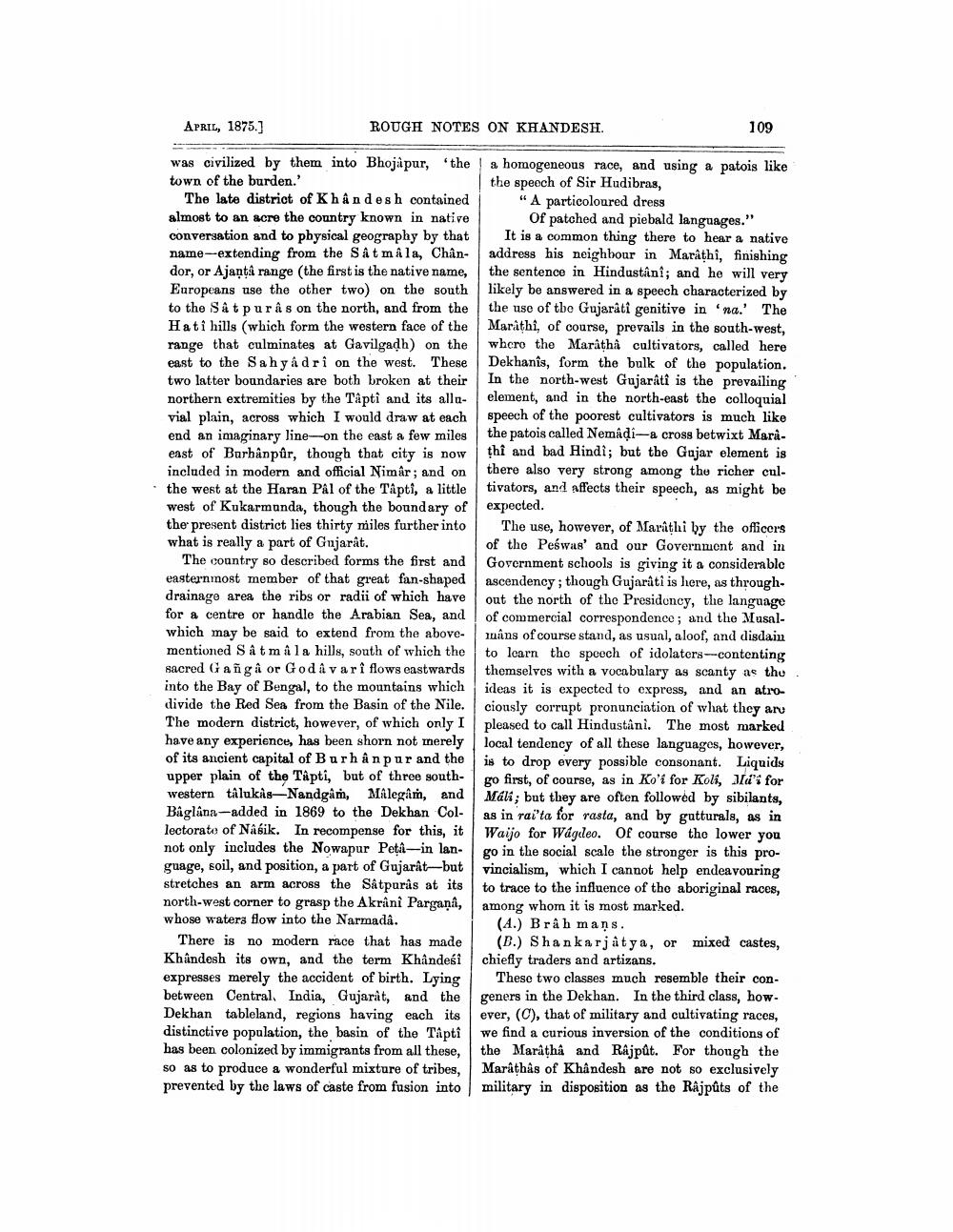________________
APRIL, 1875.]
ROUGH NOTES ON KHANDESH.
109
was civilized by them into Bhojapur, 'the town of the burden.'
The late district of Khandesh contained almost to an acre the country known in native conversation and to physical geography by that name--extending from the Sât måla, Chân- dor, or Ajanta range (the first is the native name, Europeans use the other two) on the south to the Satpurâs on the north, and from the Hati hills (which form the western face of the range that culminates at Gavilgadh) on the east to the Sahyadri on the west. These two latter boundaries are both broken at their northern extremities by the Tâpti and its allavial plain, across which I would draw at each end an imaginary line-on the east a few miles east of Burbanpûr, though that city is now included in modern and official Nimâr; and on the west at the Haran PAl of the Tapti, a little west of Kukarmanda, though the boundary of the present district lies thirty miles further into what is really a part of Gujarat.
The country so described forms the first and easternmost member of that great fan-shaped drainage area the ribs or radii of which have for a centre or handle the Arabian Sea, and which may be said to extend from the abovementioned Sat mala hills, south of which the sacred Goñiga or God a vari flows eastwards into the Bay of Bengal, to the mountains which divide the Red Sea from the Basin of the Nile. The modern district, however, of which only I have any experience, has been shorn not merely of its ancient capital of Burhanpur and the upper plain of the Tậpti, but of three southwestern tâlukis-Nandgam, Mâlegân, and Baglana--added in 1869 to the Dekhan Col- lectorate of Nasik. In recompense for this, it not only includes the Nowapur Peta-in language, soil, and position, a part of Gujarat—but stretches an arm across the Satpurås at its north-west corner to grasp the Akrani Pargana, whose water flow into the Narmada.
There is no modern race that has made Khandesh its own, and the term Khândesi expresses merely the accident of birth. Lying between Central India, Gujarat, and the Dekhan tableland, regions having each its distinctive population, the basin of the Tapti has been colonized by immigrants from all these, so as to produce a wonderful mixture of tribes, prevented by the laws of caste from fusion into
a homogeneous race, and using a patois like the speech of Sir Hudibras,
"A particoloured dress
Of patched and piebald languages." It is a common thing there to hear a native address his neighbour in Marathi, finishing the sentence in Hindustani; and he will very likely be answered in a speech characterized by the use of the Gujarati genitive in 'na.' The Marathi, of course, prevails in the south-west, whcro the Maratha cultivators, called here Dekhanîs, form the bulk of the population. In the north-west Gujarati is the prevailing element, and in the north-east the colloquial speech of the poorest cultivators is much like the patois called Nemâţi-a cross betwixt Marithî and bad Hindi; but the Gujar element is there also very strong among the richer cultivators, and affects their speech, as might be expected.
The use, however, of Marathi by the officers of the Peśwus' and our Government and in Government schools is giving it a considerable ascendency; though Gujarati is here, as through. out the north of the Presidency, the language of commercial correspondence; and the Musal
ins of course stand, as usual, aloof, and disdain to learn the speech of idolaters-contenting themselves with a vocabulary as scanty as thu ideas it is expected to express, and an atrociously corrupt pronunciation of what they are pleased to call Hindustani. The most marked local tendency of all these languages, however, is to drop every possible consonant. Liquids go first, of course, as in Ko'í for Koli, Jld's for Máli; but they are often followed by sibilants, as in rai'ta for rasta, and by gutturals, as in Waijo for Wagdeo. Of course tho lower you go in the social scale the stronger is this provincialism, which I cannot help endeavouring to trace to the influence of the aboriginal races, among whom it is most marked.
(4.) Brâh mans.
(B.) Shankarjátya, or mixed castes, chiefly traders and artizans.
These two classes much resemble their congeners in the Dekhan. In the third class, however, (C), that of military and cultivating races, we find a curious inversion of the conditions of the Maratha and Rajput. For though the Marathås of Khandesh are not so exclusively military in disposition as the Rajputs of the




